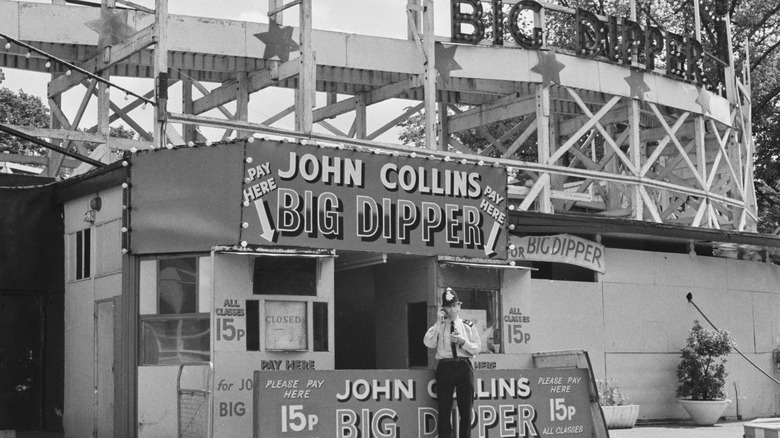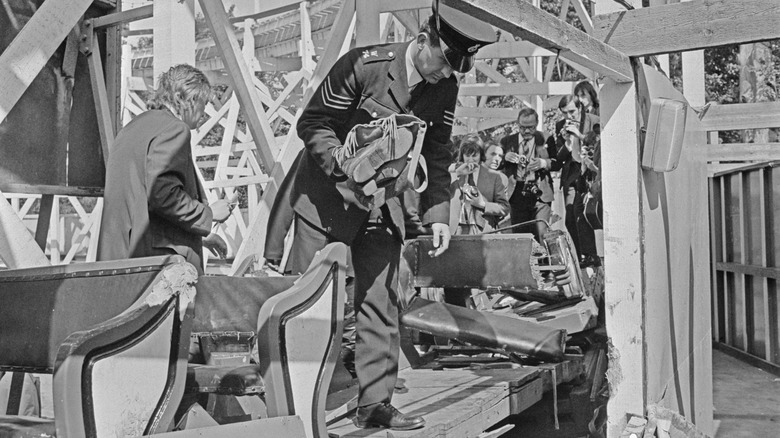The Truth About The Deadly Battersea Big Dipper Crash
Roller coasters are generally not dangerous. As reported by Popular Mechanics, the International Association of Amusement Parks and Attractions says the odds of suffering a fatal injury on an amusement park ride are one in 750 million. The average person is more likely to be attacked by a shark than be hospitalized due to an injury sustained on a roller coaster. Nevertheless, unlikely roller coaster accidents do happen, and in 1972, tragedy struck at England's Battersea Park Fun Fair when the Big Dipper roller coaster derailed, killing five children and injuring 13.
On May 30, like any other day, people got on the popular three-car wooden coaster, per Londonist. But at the top of the track's first drop, the cars detached from the drive train too soon. Although the attendant attempted to hold the coaster in place, it proved impossible. The cars went backward down the loop, hit a turn, and derailed, crushing the bottom car under the top two. Two teenagers and an 8-year-old were killed on the scene, and two more children later died from injuries sustained during the crash.
In 2015, The Independent interviewed Carolyn Adamczyk, a survivor of the Big Dipper accident. Just 14 at the time, Adamczyk recounted that she and her friends were in a relatively undamaged car with another girl who "screamed that she wanted to get off, but she leaned on a wooden barrier and it collapsed. I tried to grab for her, but I saw her fall to the ground in front of me."
Big Dipper crash survivor told to "have a cup of tea and get on with it."
Carolyn Adamczyk went on to tell The Independent that as she descended from the Big Dipper after the deadly crash, "I realized as I was walking down that I was walking on blood. I looked up, and next to the carriage people were hanging out over the tracks. There was blood everywhere." Her friend Sheila Brennan, who was also on the Big Dipper that day, noted that the survivors weren't offered any sort of help or care. "I don't recall being interviewed and I certainly don't remember the manslaughter trial that followed. We were just 14-year-old girls ... We just gave an interview to the Daily Mail then went home. That was it." Adamczyk noted that she was eventually diagnosed with post-traumatic stress disorder in 2005. Until her diagnosis, she'd never received counseling beyond "have a cup of tea and get on with it."
Londonist reported that one of the Big Dipper's cars first derailed in 1951, but no one was hurt. But a crash in 1968 resulted in a woman breaking her arm, and in 1970, the coaster suffered enormous damages after an arson attack and closed for months. As mentioned by Brennan, the 1972 disaster led to several accusations of manslaughter. Lawyers described the ride as "a death trap" and listed its defects and unsafe structures. Nevertheless, both the ride operator and the Battersea Park Fun Fair's general manager were cleared of all charges in 1973. The Big Dipper immediately closed after the accident and was disassembled and replaced with a more modern steel roller coaster, but the park never recovered and closed in 1974.
If you or someone you know is struggling with mental health, please contact the Crisis Text Line by texting HOME to 741741, call the National Alliance on Mental Illness helpline at 1-800-950-NAMI (6264), or visit the National Institute of Mental Health website.

